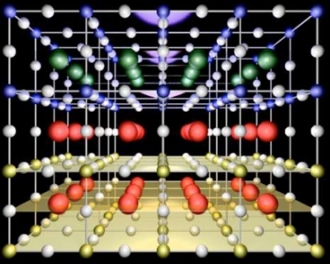May 13, 2011 — MIT researchers and their colleagues at the University of Augsburg in Germany discovered a new physical phenomenon that could yield transistors with greatly enhanced capacitance, measured at room temperature. The lanthanum aluminate and strontium titanate composition’s phenomenon could lead to the revival of clock speed as the measure of a computer’s power.
 |
| A sample of the lanthanum aluminate-strontium titanate composite, which looks like a slab of thick glass, with thin electrodes deposited on top of it. SOURCE: MIT |
MIT Professor of Physics Raymond Ashoori and Lu Li, a postdoc and Pappalardo Fellow in his lab — together with Christoph Richter, Stefan Paetel, Thilo Kopp and Jochen Mannhart of the University of Augsburg — investigated the unusual physical system that results when lanthanum aluminate is grown on top of strontium titanate. Lanthanum aluminate consists of alternating layers of lanthanum oxide and aluminum oxide. The lanthanum-based layers have a slight positive charge; the aluminum-based layers, a slight negative charge. The result is a series of electric fields that all add up in the same direction, creating an electric potential between the top and bottom of the material.
Ordinarily, both lanthanum aluminate and strontium titanate are excellent insulators. But physicists had speculated that if the lanthanum aluminate gets thick enough, its electrical potential would increase to the point that some electrons would have to move from the top of the material to the bottom, to prevent a polarization catastrophe. The result is a conductive channel at the juncture with the strontium titanate, much like the one that forms when a transistor is switched on. So Ashoori and his collaborators decided to measure the capacitance between that channel and a gate electrode on top of the lanthanum aluminate.
 |
| Stacked layers of lanthanum aluminate on layers of strontium titanate, which MIT and University of Ausburg researchers observed creating high capacitance at room temperature. |
Although results were somewhat limited by the experimental apparatus, it may be that an infinitesimal change in voltage will cause a large amount of charge to enter the channel between the two materials. "The channel may suck in charge — shoomp! Like a vacuum," Ashoori says. "And it operates at room temperature." While a lot of charge will move into the channel between materials with a slight change in voltage, it moves slowly, much too slowly for the type of high-frequency switching that takes place in computer chips. This could be due to the rough nature of the experimental composition.
The material’s capacitance is so high that the researchers don’t believe it can be explained by existing physics. "We’ve seen the same kind of thing in semiconductors," Ashoori says, "but that was a very pure sample, and the effect was very small. This is a super-dirty sample and a super-big effect."
Capacitance measures how much charge accumulates below a gate for a given voltage. The power that a chip consumes, and the heat it gives off, are roughly proportional to the square of the gate’s operating voltage. So lowering the voltage could drastically reduce the heat, creating new room to crank up the clock.
"For capacitance, there is a formula that was assumed to be correct and was used in the computer industry and is in all the textbooks," says Jean-Marc Triscone, a professor of physics at the University of Geneva, whose group has published several papers on the juncture between lanthanum aluminate and strontium titanate. "What the MIT team and Mannhart showed is that to describe their system, this formula has to be modified."
If researchers can understand the physical phenomena underlying the material’s remarkable capacitance, they may be able to reproduce them in more practical materials.
Triscone cautions that wholesale changes to the way computer chips are manufactured will inevitably face resistance. "So much money has been injected into the semiconductor industry for decades that to do something new, you need a really disruptive technology," he says.
The researchers reported their results in this week’s issue of the journal Science. Access it here: http://www.sciencemag.org/content/332/6031/825.short

